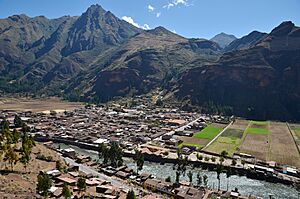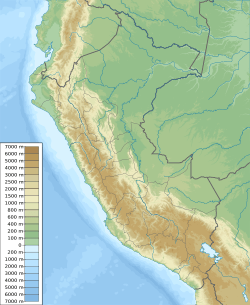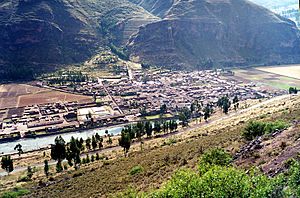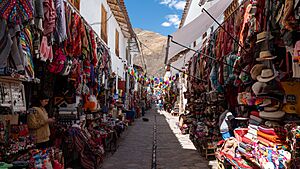Písac facts for kids
Quick facts for kids
Písac
Pisac
|
|
|---|---|
|
Town
|
|

Modern town of Pisac in the Sacred Valley
|
|
| Country | |
| Region | Cusco |
| Province | Calca |
| District | Pisac |
| Area | |
| • Total | 148.25 km2 (57.24 sq mi) |
| Elevation | 2,972 m (9,751 ft) |
| Population
(2002)
|
|
| • Total | 9,796 |
| • Density | 66.078/km2 (171.140/sq mi) |
| Time zone | UTC-5 (PET) |
Písac, also called Pisac, is a lively town in Peru's beautiful Sacred Valley of the Incas. It sits right by the Vilcanota River. Písac is famous for its amazing ancient Inca ruins and a big, colorful market. Many tourists from nearby Cusco love to visit this special place. The name Písac might come from the Quechua language, meaning a type of bird called Nothoprocta.
Contents
History of Písac
People have lived in the Písac area for a very long time. Scientists have found old pottery from the Lucre and Killke people here. This shows that communities were settled in this region long ago.
An early village existed on a hillside between two rivers, the Quitamayo and Chongo. These early people grew their crops on special terraces and on the flat land near the river. Later, as dangers from other tribes decreased, the villagers moved closer to the main road that led to Cusco.
The Inca Complex in Písac
When the Inca Empire took over the area, they built a huge complex on a mountain ridge. This ridge overlooks where the modern town of Písac is today. Most experts believe that the Inca emperor Pachacuti built it around 1440. Pachacuti ruled from 1438 to 1472.
Many scholars think that the Inca complex at Písac had several uses. It was likely a home for the emperor's family, a strong fortress, and a place to study the stars. It was also an important religious site. It served as a quiet royal retreat away from Cusco where the emperor and nobles could relax. They also performed important ceremonies there. It was a safe place during times of danger and a way to remember Pachacuti's victories.
Even though it was very large and close to Cusco, Spanish writers from that time did not mention the Inca complex. Sadly, Francisco Pizarro and the Spanish conquerors destroyed parts of the Inca complex in the early 1530s.
The modern town of Písac was built much later, in the 1570s. It was built in the valley below the old Inca ruins by a Spanish leader named Viceroy Toledo.
Rediscovering Písac
The first detailed descriptions of Písac in modern times came in the late 1800s. Ephraim George Squier, an American official, visited Písac and wrote about the Inca ruins in his 1877 book. A French scientist and explorer, Charles Wiener, also visited Písac and wrote about his discoveries in 1880.
Geography of Písac

Písac is located in the Pisac District, which is part of the Calca province. It sits at the southern end of the Sacred Valley. The town is about 2,972 metres (9,751 ft) above sea level and about 32 kilometres (20 mi) northeast of Cusco.
The town is built around the Vilcanota River. Most of the town is on the right side of the river. It has a grid pattern, meaning its streets are laid out like a checkerboard. The center of town is the Plaza Constitución, which used to be called the Plaza de Armas. For many years, a large pisonay tree stood proudly in this plaza. However, a thunderstorm in 2013 unfortunately destroyed it.
Climate in Písac
| Climate data for Písac, elevation 2,990 m (9,810 ft), (1991–2020) | |||||||||||||
|---|---|---|---|---|---|---|---|---|---|---|---|---|---|
| Month | Jan | Feb | Mar | Apr | May | Jun | Jul | Aug | Sep | Oct | Nov | Dec | Year |
| Mean daily maximum °C (°F) | 21.8 (71.2) |
21.5 (70.7) |
22.0 (71.6) |
22.7 (72.9) |
23.4 (74.1) |
23.2 (73.8) |
23.0 (73.4) |
23.4 (74.1) |
23.6 (74.5) |
23.7 (74.7) |
24.3 (75.7) |
22.7 (72.9) |
22.9 (73.3) |
| Mean daily minimum °C (°F) | 10.1 (50.2) |
10.0 (50.0) |
9.7 (49.5) |
8.2 (46.8) |
6.1 (43.0) |
4.6 (40.3) |
4.2 (39.6) |
5.3 (41.5) |
7.5 (45.5) |
9.2 (48.6) |
9.8 (49.6) |
10.0 (50.0) |
7.9 (46.2) |
| Average precipitation mm (inches) | 119.1 (4.69) |
99.8 (3.93) |
83.2 (3.28) |
26.4 (1.04) |
7.0 (0.28) |
4.6 (0.18) |
5.6 (0.22) |
6.3 (0.25) |
11.2 (0.44) |
39.7 (1.56) |
56.7 (2.23) |
99.3 (3.91) |
558.9 (22.01) |
| Source: National Meteorology and Hydrology Service of Peru | |||||||||||||
Things to See and Do in Písac
Comunitario de Pisac Museum
This museum opened in 2009. It shows how local Quechua communities make traditional pottery and textiles. One room is dedicated to the Inca people who lived in this area. It covers their history from ancient times to the powerful Inca Empire. The museum also has maps of the Inca city and displays Inca pottery and even mummies.
Iglesia San Pedro Apóstolo (Church of Saint Peter the Apostle)
This church is located in the Plaza Constitución. It was built on old Inca foundations. After an earthquake in 1950, it had to be rebuilt. More recently, the INC (National Institute of Culture) decided to rebuild the church again. They wanted it to look exactly like its original colonial style.
Inca Complex at Písac
High above the town are the impressive Inca ruins. This large complex covers more than 65.5 hectares. It stretches for about a kilometer along a mountain ridge. The ruins are located between 3,446 metres (11,306 ft) and 3,514 metres (11,529 ft) above sea level. Two rivers, the Kitamayu and the Chongo, flow on either side of the ridge.
Jardín Botanico (Felipe Marin Moreno Botanic Garden)
This beautiful garden is located in an old colonial garden. It was started in 1917 by Felipe Marín Moreno. He was a Peruvian botanist and explorer. He used the garden to try growing different plants. Over many years, he collected plants and seeds from all over the world. Felipe Marín's son, José, has now opened the garden to the public. It has been declared an important part of Peru's history.
Písac Market
Písac is very well known for its market. A big part of the market sells souvenirs for tourists. The official market days are Tuesday, Thursday, and Sunday. However, the market has become so popular that it fills the Plaza Constitución and nearby streets every day! The market is biggest on Sunday. On this day, local Quechua communities come from the surrounding areas. They sell their fresh produce, much of which is organic. They also buy supplies for the week.
Ñusta Encantada (Enchanted Princess)
On the road south of Písac, there is a rock formation. It looks like a princess carrying bags on her back. According to an Inca legend, this rock is the remains of Princess Inquill.
The legend says that Chief Huayllapuma and his people were often attacked by the Antis tribe. The Antis would attack during the rainy season. The Incas, who were allies, could not help because the Vilcanota River was too high to cross. The chief had a daughter named Inquill Chumpi. An oracle (a person who can see the future) named Wankar Kuichi had a prophecy. He said that Inquill would only marry a prince who could build a bridge over the river in one night.
Inquill turned down many suitors. Then, one day, a young man named Asto Rimaq arrived. He was the son of a chief from a mysterious kingdom. Asto Rimaq brought many wonderful gifts. One gift was a special bird called Qoriqenqe. This bird had golden feathers and could tell the future with its sweet song.
When the bird heard about the prophecy, it said that the bridge would be built in one night. It also said that the stones would move by themselves from the quarries. The bird told Inquill and Asto Rimaq to cross the river. Asto Rimaq had to stay on the river bank. Inquill had to climb the slope, carrying bags of coca leaves. She had to kiss the bags and let the leaves fall as a sacred offering. The bird warned them that if Inquill turned to look back, they would never see each other again. This would also end their people's hope.
Inquill promised to follow the bird's instructions. After crossing the river, she started to climb the slope. As soon as the first handful of coca fell, the ground began to shake. The shaking grew stronger, and stones started to move by themselves. Blocks of stone flew over the water. The ground moved as if it were alive. Some stones rubbed together, creating lightning. Suddenly, everything stopped. At that moment, Inquill became curious. She turned to look back. Instantly, she turned into stone. Asto Rimaq was drowned by the river.
Sanctuario del Senor de Huanca (Sanctuary of the Lord of Huanca)
This is a Christian shrine that was built in the 1700s. It was officially recognized in 1779. The shrine is about 8 kilometres (5.0 mi) southeast of Písac. Many pilgrims travel to this shrine every September.
Gallery
See also
 In Spanish: Písac (sitio arqueológico) para niños
In Spanish: Písac (sitio arqueológico) para niños











